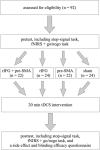Multitarget high-definition transcranial direct current stimulation improves response inhibition more than single-target high-definition transcranial direct current stimulation in healthy participants
- PMID: 35968393
- PMCID: PMC9372262
- DOI: 10.3389/fnins.2022.905247
Multitarget high-definition transcranial direct current stimulation improves response inhibition more than single-target high-definition transcranial direct current stimulation in healthy participants
Abstract
Prior studies have focused on single-target anodal transcranial direct current stimulation (tDCS) over the right inferior frontal gyrus (rIFG) or pre-supplementary motor area (pre-SMA) to improve response inhibition in healthy individuals. However, the results are contradictory and the effect of multitarget anodal stimulation over both brain regions has never been investigated. The present study aimed to investigate the behavioral and neurophysiological effects of different forms of anodal high-definition tDCS (HD-tDCS) on improving response inhibition, including HD-tDCS over the rIFG or pre-SMA and multitarget HD-tDCS over both areas. Ninety-two healthy participants were randomly assigned to receive single-session (20 min) anodal HD-tDCS over rIFG + pre-SMA, rIFG, pre-SMA, or sham stimulation. Before and immediately after tDCS intervention, participants completed a stop-signal task (SST) and a go/nogo task (GNG). Their cortical activity was recorded using functional near-infrared spectroscopy (fNIRS) during the go/nogo task. The results showed multitarget stimulation produced a significant reduction in stop-signal reaction time (SSRT) relative to baseline. The pre-to-post SSRT change was not significant for rIFG, pre-SMA, or sham stimulation. Further analyses revealed multitarget HD-tDCS significantly decreased SSRT in both the high-performance and low-performance subgroups compared with the rIFG condition which decreased SSRT only in the low-performance subgroup. Only the multitarget condition significantly improved neural efficiency as indexed by lower △oxy-Hb after stimulation. In conclusion, the present study provides important preliminary evidence that multitarget HD-tDCS is a promising avenue to improve stimulation efficacy, establishing a more effective montage to enhance response inhibition relative to the commonly used single-target stimulation.
Keywords: fNIRS; high-definition transcranial direct current stimulation (HD-tDCS); pre-supplementary motor area (pre-SMA); response inhibition; right inferior frontal gyrus (rIFG).
Copyright © 2022 Guo, Gong, Lu, Qiu, Wang, Zhu and You.
Conflict of interest statement
The authors declare that the research was conducted in the absence of any commercial or financial relationships that could be construed as a potential conflict of interest.
Figures





Similar articles
-
Long-term effects of repeated multitarget high-definition transcranial direct current stimulation combined with cognitive training on response inhibition gains.Front Neurosci. 2023 Mar 9;17:1107116. doi: 10.3389/fnins.2023.1107116. eCollection 2023. Front Neurosci. 2023. PMID: 36968503 Free PMC article.
-
Transcranial direct current stimulation facilitates response inhibition through dynamic modulation of the fronto-basal ganglia network.Brain Stimul. 2020 Jan-Feb;13(1):96-104. doi: 10.1016/j.brs.2019.08.004. Epub 2019 Aug 7. Brain Stimul. 2020. PMID: 31422052 Free PMC article.
-
Response Inhibition Induced in the Stop-signal Task by Transcranial Direct Current Stimulation of the Pre-supplementary Motor Area and Primary Sensoriomotor Cortex.J Phys Ther Sci. 2013 Sep;25(9):1083-6. doi: 10.1589/jpts.25.1083. Epub 2013 Oct 20. J Phys Ther Sci. 2013. PMID: 24259920 Free PMC article.
-
Effects of transcranial direct current stimulation on modulating executive functions in healthy populations: a systematic review and meta-analysis.Front Hum Neurosci. 2024 Dec 13;18:1485037. doi: 10.3389/fnhum.2024.1485037. eCollection 2024. Front Hum Neurosci. 2024. PMID: 39734667 Free PMC article.
-
The Effect of a Single Session of Non-Invasive Brain Stimulation on Balance in Healthy Individuals: A Systematic Review and Best Evidence Synthesis.Brain Connect. 2021 Nov;11(9):695-716. doi: 10.1089/brain.2020.0872. Epub 2021 Sep 3. Brain Connect. 2021. PMID: 33798002
Cited by
-
A modified neural circuit framework for semantic memory retrieval with implications for circuit modulation to treat verbal retrieval deficits.Brain Behav. 2024 May;14(5):e3490. doi: 10.1002/brb3.3490. Brain Behav. 2024. PMID: 38680077 Free PMC article. Review.
-
Anodal transcranial direct current stimulation enhances response inhibition and attention allocation in fencers.PeerJ. 2024 Apr 29;12:e17288. doi: 10.7717/peerj.17288. eCollection 2024. PeerJ. 2024. PMID: 38699193 Free PMC article. Clinical Trial.
-
Protocol for a randomized controlled trial: efficacy and mechanisms of dual-target anodal tDCS in post-stroke cognitive impairment.Front Hum Neurosci. 2025 Aug 13;19:1603797. doi: 10.3389/fnhum.2025.1603797. eCollection 2025. Front Hum Neurosci. 2025. PMID: 40881933 Free PMC article.
-
[Research progress on transcranial electrical stimulation for deep brain stimulation].Sheng Wu Yi Xue Gong Cheng Xue Za Zhi. 2023 Oct 25;40(5):1005-1011. doi: 10.7507/1001-5515.202210012. Sheng Wu Yi Xue Gong Cheng Xue Za Zhi. 2023. PMID: 37879931 Free PMC article. Review. Chinese.
-
Network-targeted transcranial direct current stimulation of the hypothalamus appetite-control network: a feasibility study.Sci Rep. 2024 May 18;14(1):11341. doi: 10.1038/s41598-024-61852-3. Sci Rep. 2024. PMID: 38762574 Free PMC article.
References
-
- Abellaneda-Perez K., Vaque-Alcazar L., Perellon-Alfonso R., Sole-Padulles C., Bargallo N., Salvador R., et al. (2021). Multifocal transcranial direct current stimulation modulates resting-state functional connectivity in older adults depending on the induced current density. Front. Aging Neurosci. 13:725013. 10.3389/fnagi.2021.725013 - DOI - PMC - PubMed
-
- Alizadehgoradel J., Nejati V., Movahed F. S., Imani S., Taherifard M., Mosayebi-Samani M., et al. (2020). Repeated stimulation of the dorsolateral-prefrontal cortex improves executive dysfunctions and craving in drug addiction: a randomized, double-blind, parallel-group study. Brain Stimul. 13 582–593. 10.1016/j.brs.2019.12.028 - DOI - PubMed
LinkOut - more resources
Full Text Sources

